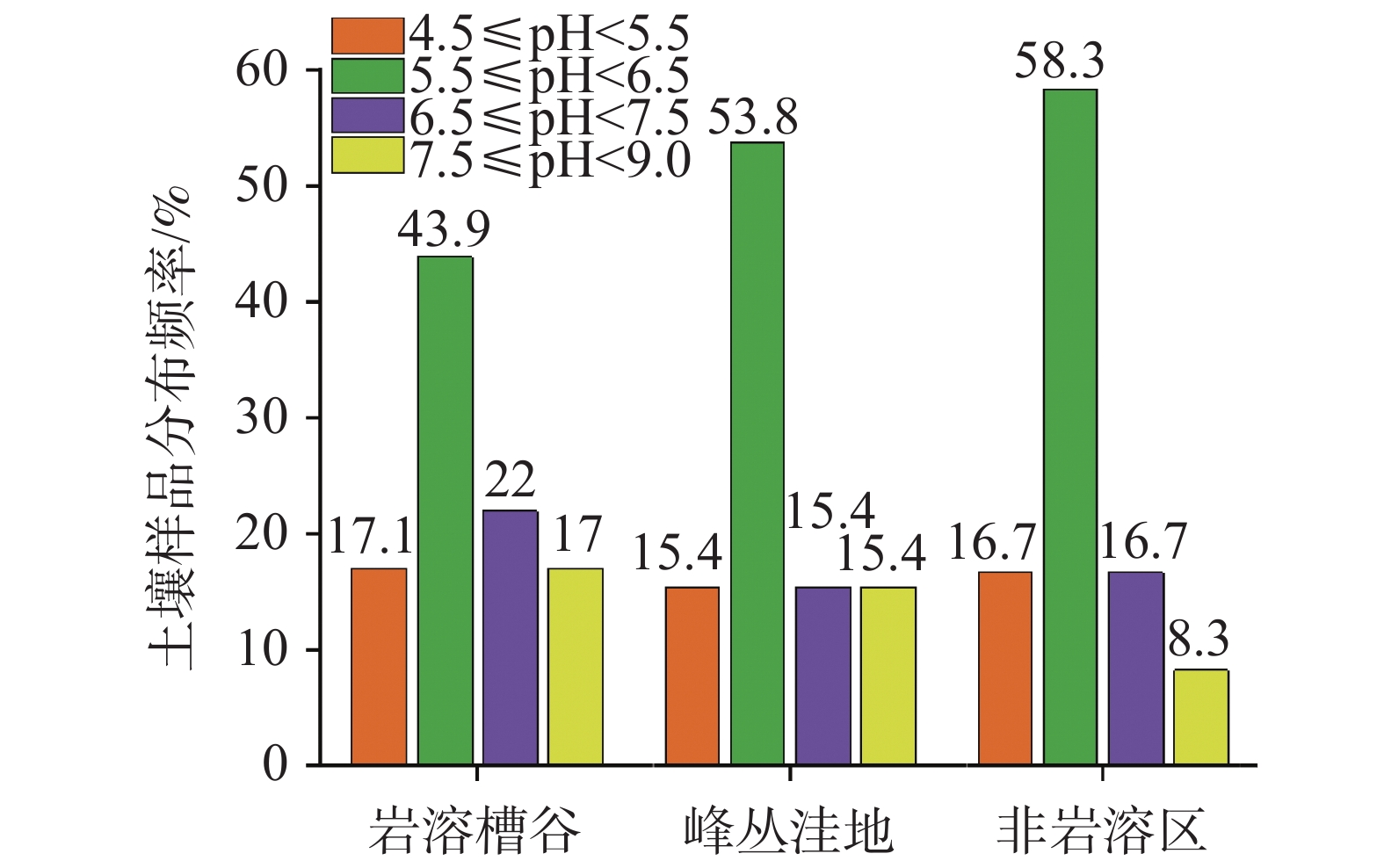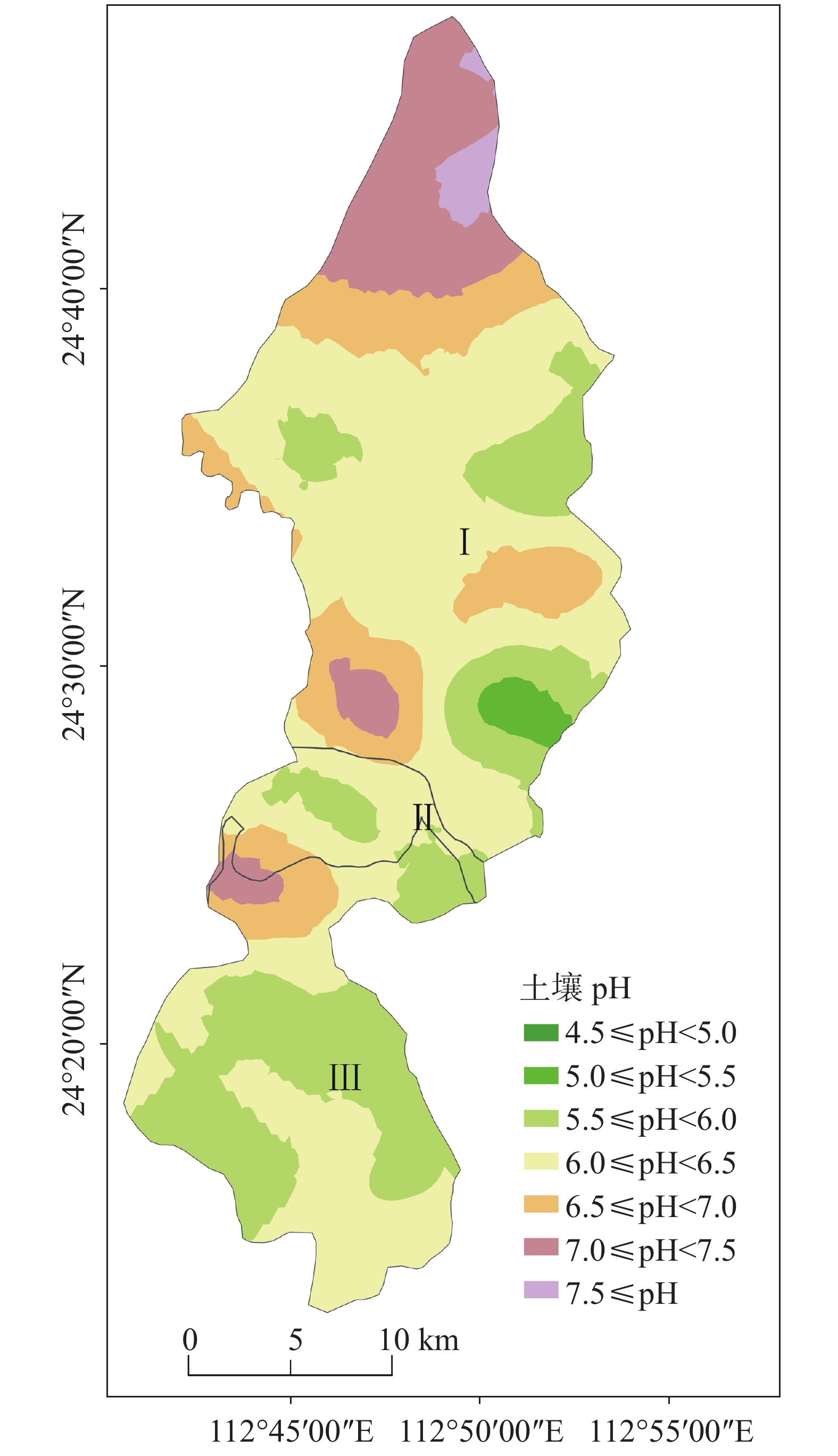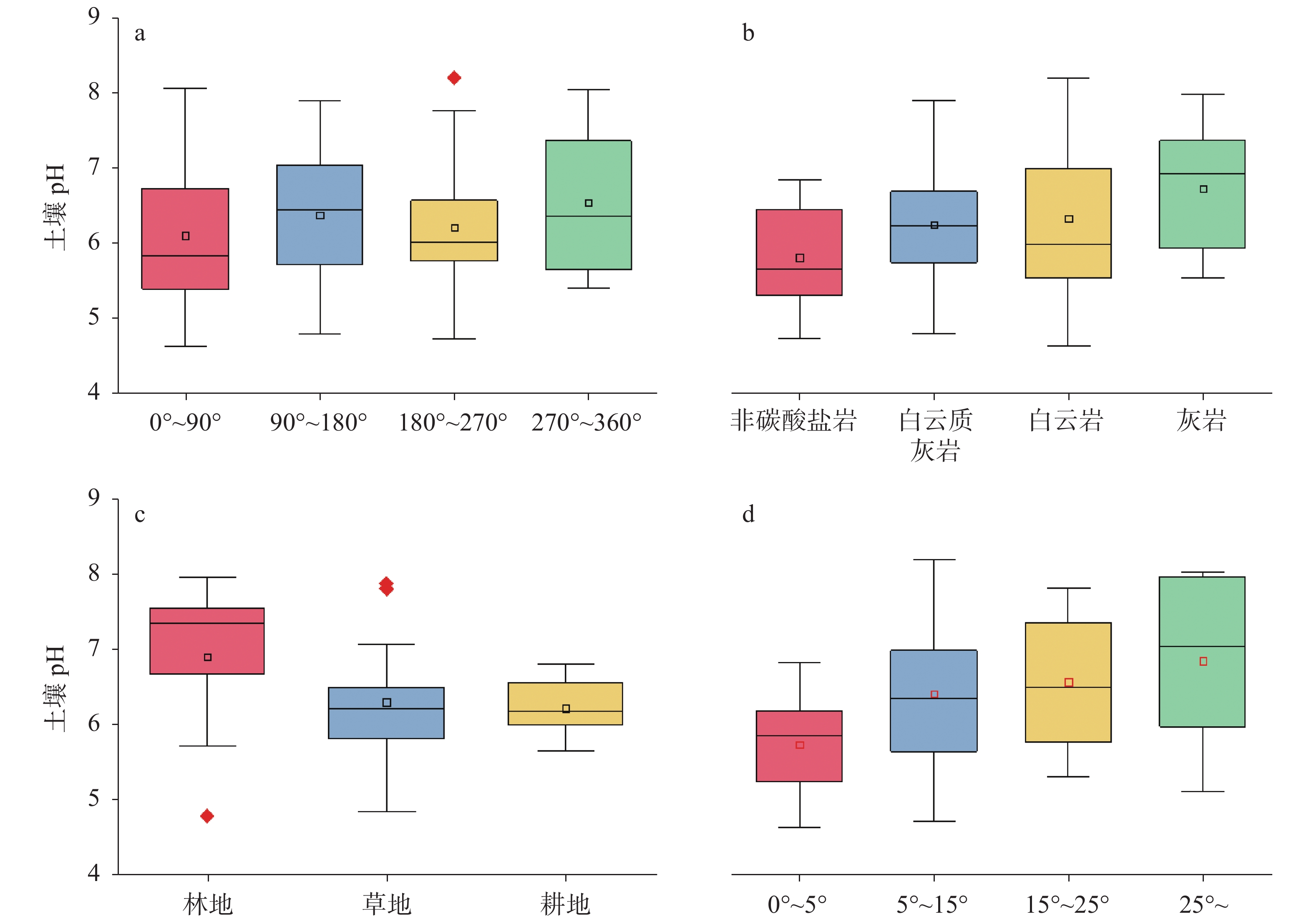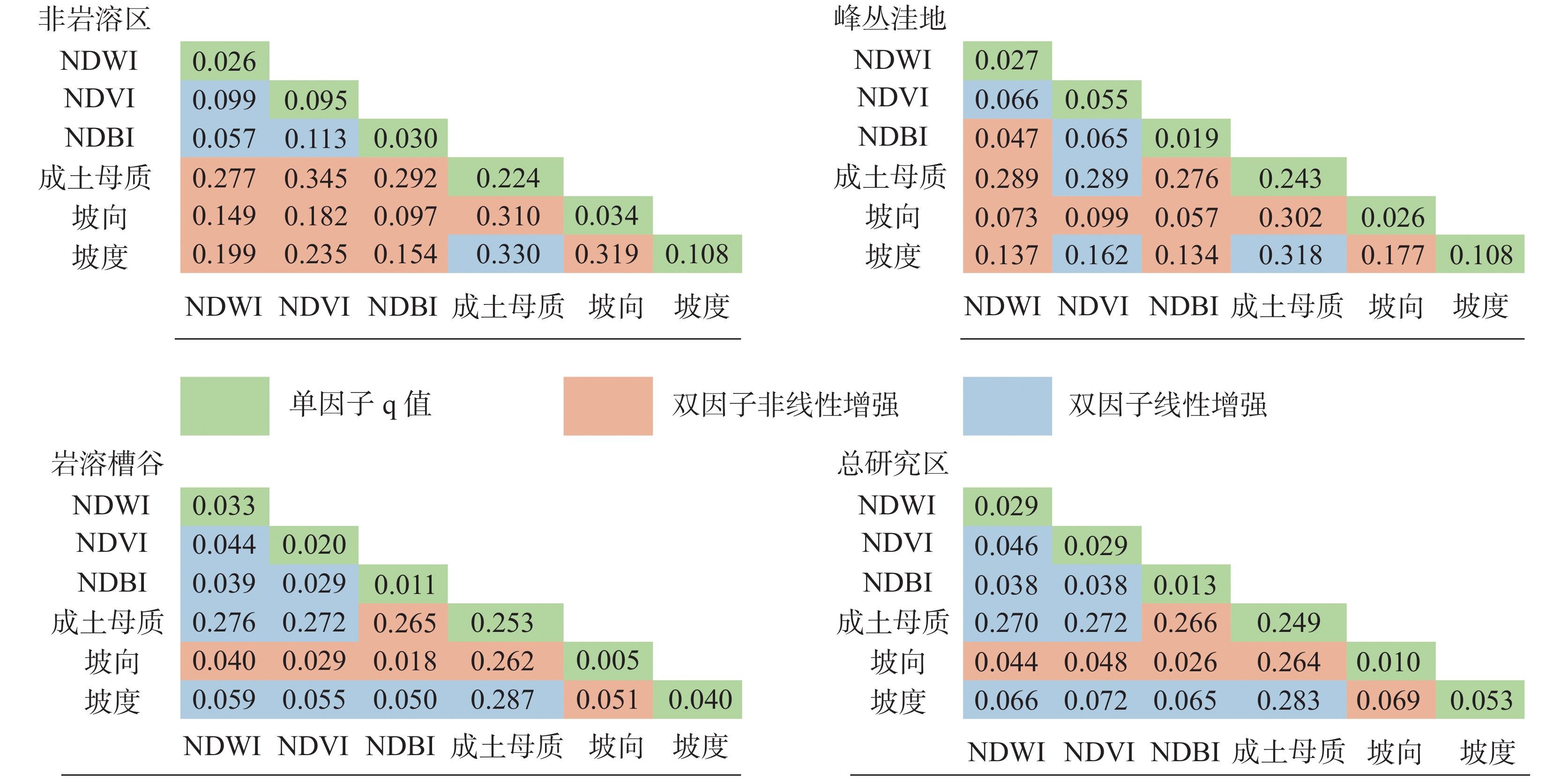Spatial variation of soil acidification in the karst area of northern Guangdong: A case in peak cluster depression and karst trough valley landforms
-
摘要:
为了解粤北岩溶区土壤酸化的空间分异特征,选择华南酸雨区的岩溶槽谷地貌和峰丛洼地地貌土壤为研究对象,对土壤pH数据进行空间插值预测,采用参数最优地理探测器分析岩溶槽谷地貌与峰丛洼地地貌中土壤酸化的空间特征及关键驱动力。结果表明:(1)区内土壤pH范围为4.62~8.19,主要以弱酸性(5.5≤pH <6.5)和酸性(4.5≤pH<5.5)为主。在不同地貌类型中,pH<6.5的土壤样品占比顺序为:岩溶槽谷(61.0%)< 峰丛洼地(69.2%)<非岩溶区(75.0%);(2)岩溶区小生境复杂多样,在酸雨影响下,成土母质可能是研究区内控制土壤pH的关键因子,而土壤pH空间分异格局可能是多因子共同作用的结果;(3)坡度对土壤pH空间分异的影响仅次于成土母质,表现为土壤pH随坡度的增加而升高,且其与成土母质的交互作用对研究区内土壤pH空间分异的解释力最大。区内土壤酸化防治建议:(1)根据成土母质和坡度因子进行分区分类,并在岩溶槽谷和非岩溶区内设定土壤酸化重点监测区,进行精准防治;(2)除了对酸雨的防控外,还应该重视诸如氮肥使用、工业和矿业活动等外源性因素对土壤的影响。
Abstract:The process of soil acidification is very slow under the natural conditions, which generally takes decades or even hundreds of years. However, since the Industrial Revolution, human activities have greatly accelerated the process of soil acidification. The effect of acid rain is one of the main reasons for the process. The problems caused by soil acidification, such as barren soil, soil quality decline, enhanced heavy metal activities and others will affect soil microbial activities and the growth of plants, and then affect the quality of ecological environment in the whole region, hence threating the food safety and human health. Soil acidification has become an important ecological and environmental problem that has to be faced in the agriculture development of south China. Therefore, distribution of soil pH is the key to control measures for soil acidification in karst areas.
In order to study the spatial variation of soil acidification in karst areas, an investigation was conducted to assess the status of soil pH in the karst trough landform and cluster-peak depression landform in northern Guangdong located in the acid rain area of south China. Methods such as normalized vegetation index (NDVI), normalized moisture index (NDWI), normalized building index (NDBI), slope aspect and gradient were used to analyze the driving mechanism of soil pH heterogeneity in cluster-peak depression and karst trough valley. The research questions are listed as follows, (1) What are the characteristics of spatial variation of soil pH in different karst landforms and what are the main influencing factors of the variation? (2) What are the driving factors and interactive effects of soil acidification in karst areas?
The results show that pH values of the total soil samples range from 4.62 to 8.19 with the mean of 6.29±0.92 and the variance of 0.85; the soil pH values in karst trough valley range from 4.62 to 8.19 with the mean of 6.38±0.95 and the variance of 0.91; the pH values in cluster-peak depression range from 5.29 to 8.03 with the mean of 6.31±0.90 and the variance of 0.81; the pH values in non-karst area range from 4.71 to 7.55 with the mean of 5.99±0.92 and the variance of 0.73. Generally speaking, the average soil pH of total samples shows weak acidity, and no soil samples with strong acidity (pH<4.5) are detected, but alkaline soil samples (pH≥7.5) in some landforms are detected. The results indicate a substantial impact of acid rain on the soil pH of karst areas and the risk of soil acidification. According to the distribution frequency of soil pH values, the soil pH in the whole study area is mainly weakly acid and acid. The pH values (<6.5) of soil samples in different landforms are ranked as follows, karst trough valley (61.0%)<cluster-peak depression (69.2%)<non-karst area (75.0%), indicating that soil acidification in the study area has been widespread and its control is urgent.
Through the analysis of the spatial characteristics of soil pH, the variation of the mean value of soil pH presents the following rules, (1) Distribution of the soil pH shows that soil parent materials directly affect the process of soil acidification. Under the conditions of different soil parent materials, the mean values of soil pH are ranked as, non-carbonate<dolomitic limestone<dolomite<limestone, indicating that the buffer capacity of carbonate rock is stronger than that of non-carbonate rock. (2) Soil pH values in the study area increase with the rise of gradient, but the factor of slope aspect does not show an obvious influence on distribution of soil pH. These results indicate that the influence of the gradient factor in the study area is stronger than that of the slope aspect. (3) In the karst trough valley, the mean values of soil pH in different land use types are ranked as, woodland>grassland>cultivated land, indicating that the land use type, in some degree, is influential in the spatial variation of soil pH.
The karst environment is very complex. With the effect of acid rain, the soil parent materias, which may be the key factor to control the soil pH in the study area, directly affect the process of soil acidification. But distribution of soil pH spatial variation may be caused by multiple factors. In general, soil pH values in the study area show an increase with the rise of gradient. The influence of gradient on soil pH spatial variation is followed by that of soil parent materials. The interactive effect of gradient and soil parent materials shows great explanatory power for the spatial variation of soil pH in the study area. Therefore, soil acidification control is advisably to be carried out in northern Guangdong, and the gradient factor should be taken as one of the indicators. Besides the influence of acid rain, other exogenous factors such as nitrogen fertilizer, and industrial and mining activities, should also be paid attention to.
With the integration of geostatistics, the geodetector is used to further analyze the driving factors of soil pH spatial variation and their interactive effects in the karst area in north Guangdong, based on the forecast of soil pH kriging spatial interpolation. However, the effect of rocky desertification and the scaling effects of different sizes of spatial statistical units on the geodetector model have not been fully explored. These limitations will be overcome in the future research.
-
Key words:
- soil acidification /
- soil pH /
- cluster-peak depression /
- karst trough valley /
- geodetector
-

-
表 1 交互作用判断公式
Table 1. Judgment formula of interaction
交互作用 判据 加强 q(x1∩x2)>q(x1)或q(x2) 加强,双线性 q(x1∩x2)> q(x1)和q(x2) 加强,非线性 q(x1∩x2)> q(x1)+ q(x2) 减弱 q(x1∩x2)< q(x1)+ q(x2) 减弱,单线性 q(x1∩x2)< q(x1)或q(x2) 减弱,非线性 q(x1∩x2)< q(x1)和q(x2) 独立 q(x1∩x2)= q(x1)+ q(x2) 表 2 不同地貌类型土壤pH的统计表
Table 2. Descriptive statistics of soil pH in different landforms
统计分类 样本数/个 最小值 最大值 平均值 标准差 方差 岩溶槽谷区 41 4.62 8.19 6.38 0.95 0.91 峰丛洼地区 12 5.29 8.03 6.31 0.90 0.81 非岩溶区 13 4.71 7.75 5.99 0.85 0.73 研究区 66 4.62 8.19 6.29 0.92 0.85 -
[1] 张玲玉, 赵学强, 沈仁芳. 土壤酸化及其生态效应[J]. 生态学杂志, 2019, 38(06):1900-1908.
ZHANG Lingyu, ZHAO Xueqiang, SHEN Renfang. Soil acidification and its ecological effects[J]. Chinese Journal of Ecology, 2019, 38(06):1900-1908.
[2] Else K. Bunemann, Giulia Bongiorno, BAI Zhanguo, Rachel E Creamer, Gerlinde De Deyn, Ron De Goede, Luuk Fleskens, Violette Geissen, Thom W. Kuyper, Paul Mader, Mirjam Pulleman, Wijnand Sukkel, Jan Willem van Groenigen, Lijbert Brussaard Soil quality: A critical review[J]. Soil Biology & Biochemistry, 2018, 120:105-125.
[3] 薛跃, 张忠启, 沈玉叶, 李景章. 典型红壤区土壤pH时空变异特征: 以鹰潭市余江区为例[J]. 土壤通报, 2020, 51(6): 1323-1331.
XUE Yue, ZHANG Zhongqi, SHEN Yuye, LI Jingzhang. Spatio-temporal Variability of Soil pH in the Typical Red Soil Region- Take Yujiang District of Yingtan as an Example[J]. Chinese Journal of Soil Science, 2020, 51(6): 1323-1331.
[4] 张晗, 赵小敏, 朱美青, 欧阳真程, 郭熙, 匡丽花, 叶英聪, 黄聪, 汪晓燕, 李伟峰. 近30年南方丘陵山区耕地土壤养分时空演变特征: 以江西省为例[J]. 水土保持研究, 2018, 25(2): 58-65,71,2.
ZHANG Han, ZHAO Xiaomin, ZHU Meiqing, OUYANG Zhencheng, GUO Xi, KUANG Lihua, YE Yingcong, HUANG Cong, WANG Xiaoyan, LI Weifeng. Characteristics of spatiotemporal variability of cultivated soil nutrients in the southern hilly area of China in the past 30 years: A case study of Jiangxi province[J]. Research of Soil and Water Conservation, 2018, 25 (2): 58-65, 71, 2.
[5] 毛伟, 李文西, 高晖, 陈欣, 姜义, 杭天文, 龚鑫鑫, 陈明, 张月平. 扬州市耕地土壤pH值30年演变及其驱动因子[J]. 植物营养与肥料学报, 2017, 23(4): 883-893.
MAO Wei, LI Wenxi, GAO Hui, CHEN Xin, JIANG Yi, HANG Tianwen, GONG Xinxin, CHEN Ming, ZHANG Yueping. pH variation and the driving factors of farmlands in Yangzhou for 30 years[J]. Journal of Plant Nutrition and Fertilizer, 2017, 23(4): 883-893.
[6] 刘月娇, 张洋, 倪九派, 周川. 基于地统计学烟区土壤养分及pH值空间异质性分析: 以重庆市酉阳县岩溶区为例[J]. 中国岩溶, 2014, 33(3): 319-325.
LIU Yuejiao, ZHANG Yang, NI Jiupai, ZHOU Chuan. Spatial heterogeneity of soil nutrients and pH in tobacco area based on geostatistics: A case study in a karst area of Youyang county, Chongqing[J]. Carsologica Sinica, 2014, 33(3): 319-325.
[7] F Bastida, A Zsolnay, T Hernandez, C Garcia. Past, present and future of soil quality indices: A biological perspective[J]. Geoderma, 2008, 147(3-4):159-171. doi: 10.1016/j.geoderma.2008.08.007
[8] 王娇, 关欣, 黄苛, 朱睦楠, 宿秀江, 杨庆朋. 酸沉降对森林生态系统碳循环关键过程的影响研究进展[J]. 应用与环境生物学报, 2021, 27(3): 776-785.
WANG Jiao, GUAN Xin, HUANG Ke, ZHU Munan, SU Xiujiang, YANG Qingpeng. Effect of acid deposition on the key processes in the carbon cycle of forest ecosystems: a review [J]. Chinese Journal of Applied and Environmental Biology, 2021, 27 (3): 776-785.
[9] 刘娇娴, 崔骏, 刘洪宝, 潘琦, 何小松. 土壤改良剂改良酸化土壤的研究进展[J]. 环境工程技术学报, 2022, 12(1): 173-184.
LIU Jiaoxian, CUI Jun, LIU Hongbao, PAN Qi, HE Xiaosong. Research progress of soil amelioration of acidified soil by soil amendments[J]. Journal of Environmental Engineering Technology, 2022, 12(1): 173-184.
[10] 黄金国, 魏兴琥, 王兮之. 粤北岩溶山区土地石漠化成因及其生态经济治理模式[J]. 水土保持研究, 2013, 20(4): 105-109.
HUANG Jinguo, WEI Xinghu, WANG Xizhi. The origin and eco-economics improvement model of the rock desertification in karst mountain area of northern Guangdong[J]. Research of Soil and Water Conservation, 2013, 20(4): 105-109.
[11] 贺婧, 赵亚平, 关连珠. 土壤中游离碳酸钙对土壤pH及酶活性的影响[J]. 沈阳农业大学学报, 2011, 42(5): 614-617.
HE Jing, ZHAO Yaping, GUAN Lianzhu. Effect of free calcium carbonate on soil pH and enzyme activities[J]. Journal of Shenyang Agricultural University, 2011, 42(5): 614-617
[12] 郭治兴, 王静, 柴敏, 陈泽鹏, 詹振寿, 郑武平, 魏秀国. 近30年来广东省土壤pH值的时空变化[J]. 应用生态学报, 2011, 22(2): 425-430.
GUO Zhixing, WANG Jing, CAI Min, CHENG Zhepeng, ZHAN Zhensou, ZHEN Wuping, WEI Xiuguo. Spatiotemporal variation of soil pH in Guangdong province of China in past 30 years[J]. Chinese journal of applied ecology, 2011, 22(2): 425-430.
[13] 王亚男, 徐梦洁, 代圆凤, 符德龙, 黄化刚, 陈 雪, 庄舜尧. 毕节市耕地土壤pH的空间变异特征与影响因素[J]. 土壤, 2018, 50(2): 385-390
WANG Yanan, XU Mengjie, DAI Yuanfeng, FU Delong, HUANG Huagang, CHEN Xue, ZHUANG Shunyao. Spatial Characteristics and Influential Factors of Arable Soil pH in Bijie, Guizhou[J]. Soils, 2018, 50(2): 385-390
[14] 蒋勇军. 流域尺度的岩溶区土壤pH值空间变异研究: 以云南小江流域为例[J]. 中国岩溶, 2009, 28 (1): 80-86
JIANG Yongjun. Spatial variability of karst soil pH on drainage basin scale: A case in Xiaojiang basin, Yunnan[J]. Carsologica Sinica, 2009, 28(1): 80-86.
[15] 张维, 李启权, 王昌全, 袁大刚, 罗由林, 张新, 贾荔. 川中丘陵县域土壤pH空间变异及影响因素分析: 以四川仁寿县为例[J]. 长江流域资源与环境, 2015, 24(7): 1192-1199.
ZHANG Wei, LI Qiquan, WANG Cangquan, YUAN Dagang, LUO Youlin, ZHANG Xin, JIA Li. Spatial variability of soil pH and its influence factors at a county scale in hilly area of mid-Sichuan basin:A case study from Renshou in Sichuan[J]. Resources and Environment in the Yangtze Basin, 2015, 24 (7): 1192-1199.
[16] 王兮之, 甘春英, 梁钊雄, 高全洲. 粤北岩溶山区连江流域植被覆盖度动态变化研究[J]. 中国岩溶, 2010, 29(4): 425-433.
WANG Xizhi, GAN Chunying, LIANG Zhaoxiong, GAO Quanzhou. Regime of vegetation coverage in Lianjiang watershed in North Guangdong karst mountain[J]. Carsologica Sinica, 2010, 29(4): 425-433.
[17] 黄至颖, 刘鸿雁, 冉晓追, 王雪雯, 蒲利明. 贵州省土壤pH时空变化趋势分析[J]. 山地农业生物学报, 2020, 39(4): 21-29.
HUANG Zhiying, LIU Hongyan, RAN Xiaozhui, WANG Xuewen, PU Liming. Spatial and Temporal Distribution of Soil pH in Guizhou Province[J]. Journal of mountain agriculture and biology, 2020, 39(4): 21-29.
[18] 王洪, 曹婧, 毋俊华, 陈怡平. 近 40 年来陕西省耕层土壤 pH 的时空变化特征[J]. 中国生态农业学报(中英文), 2021, 29(6): 1117-1126
WANG Hong, CAO Jing, WU Junhua, CHEN Yiping. Spatial and temporal variability in soil pH of Shaanxi Province over the last 40 years[J]. Chinese Journal of Eco-Agriculture, 2021, 29(6): 1117-1126.
[19] 康璇, 王雪梅, 赵枫. 干旱区绿洲土壤pH值与电导率的空间变异研究[J]. 西南农业学报, 2016, 29(11): 2660-2664.
KANG Xuan, WANG Xuemei, ZHAO Feng. Study on spatial variability of soil pH value and conductivity in arid oases[J]. Southwest China journal of agricultural sciences, 2016, 29(11): 2660-2664.
[20] 朱小琴, 孙维侠, 黄标, 王洪杰, 赵永存, 史学正, 于东升. 长江三角洲城乡交错区农业土壤pH特征及影响因素探: 以江苏省无锡市为例[J]. 土壤学报, 2009, 46(4): 594-602.
ZHU Xiaoqin, SUN Weixia, WANG Biao, WANG Hongjie, ZHAO Yongcun, SHI Xuezheng, YU Dongsheng. pH characters of agricultural soil in peri-urban areas of the Yangtze River Delta Region and their affecting factors:A case study of Wuxi City, China[J]. Acta Pedologica Sinica, 2009, 46(4): 594-602.
[21] 张忠启, 茆 彭, 于东升, 徐 莉. 近25年来典型红壤区土壤pH变化特征: 以江西省余江县为例[J]. 土壤学报, 2018, 55(6): 1545-1553
ZHANG Zhongqi, MAO Peng, YU Dongsheng, XU Li. Characteristics of Soil pH Variation in Typical Red Soil Region of South China in the Past 25 Years:A Case Study of Yujiang County, Jiangxi Province[J]. Acta Pedologica Sinica, 2018, 55(6): 1545-1553.
[22] 孔德莉, 张海涛, 何迅, 任文海, 胡群中, 肖斯予, 武学妍. 基于PLSPM模型的鄂西南部分区域耕地土壤pH影响因素研究[J]. 土壤, 2021, 53(4): 809-816.
KONG Deli, ZHANG Haitao, HE Xun, REN Wenhai, HU Qunzhong, XIAO Siyu, WU Xueyan. Influencing Factors of Farmland Soil pH in Southwest Hubei Based on PLSPM Model[J]. Soils, 2021, 53(4): 809-816
[23] 尹辉, 蒋忠诚, 杨奇勇, 李晖. 典型岩溶区土壤pH值的空间异质性研究[J]. 广东农业科学, 2013, 40(11): 48-51,237
YIN Hui, JIANG Zhongcheng, YANG Qiyong, LI Hui. Study of spatial variability of soil pH in typical karst area[J]. Guangdong Agricultural Sciences, 2013, 40(11): 48-51,237.
[24] 陈清霞, 陆晓辉, 涂成龙. 安顺市土壤pH空间变异及影响因素分析[J]. 环境科学, 2022, 43(4): 2124-2132
CHEN Qingxia, LU Xiaohui, TU Chenglong. Spatial variation and influencing factors of soil in Anshun city[J]. Environmental science, 2022, 43(4): 2124-2132.
[25] CAO Feng, GE Yong, WANG Jingfeng. Optimal discretization for geographical detectors-based risk assessment[J]. Giscience & Remote Sensing, 2013, 50(1):78-92.
[26] 王劲峰, 徐成东. 地理探测器: 原理与展望[J]. 地理学报, 2017, 72(1): 116-134
WANG Jingfeng, XU Chengdong. Geodetector: Principle and prospective[J]. Acta Geographica Sinica, 2017, 72(1): 116-134.
[27] 张桥, 张育灿, 郑超, 袁宇志, 郭治兴, 梁雪映, 王帅, 郭颖. 广东粮食生产功能区土壤 pH 值的时空变化[J]. 土壤通报, 2020, 51(4): 775-783.
ZHANG Qiao, ZHANG Yucan, ZHENG Chao, YUAN Yuzhi, GUO Zhixing, LIANG Xueying, WANG Shuai,GUO Ying. Temporal-spatial Changes of Soil pH Value in the Grain Production Functional Areas of Guangdong Province[J]. Chinese Journal of Soil Science, 2020, 51(4): 775-783.
[28] 周峻宇, 李明德, 周旋, 唐珍琦, 谷雨, 吴海勇, 刘琼峰. 南方典型母质发育水稻土剖面酸化特征研究[J]. 中国土壤与肥料, 2022(3): 7-13.
ZHOU Junyu, LI Mingde, ZHOU Xuan, TANG Zhenqi, GU Yu, WU Haiyong, LIU Qiongfeng. Study on acidification characteristics of paddy soils profiles developed from typical parent materials in south China[J]. Soil and Fertilizer Sciences in China, 2022(3): 7-13.
[29] 张元培, 吴颖, 郑雄伟. 湖北省土壤酸碱度趋势分析及影响因素[J]. 资源环境与工程, 2018, 32(S1): 30-34.
ZHANG Yuanpei, WU Ying, ZHENG Xiongwei. Trend Analysis and Influencing Factors of Soil Acidity and Alkalinity in Hubei[J]. Resources Environment & Engineering, 2018, 32(S1): 30-34.
[30] 蔡凯, 高维常, 潘文杰, 姜超英, 张恒, 李洪勋, 林叶春. 贵州烟田土壤pH、交换性钙镁和CaCO3含量分布特征及其相互关系[J]. 土壤通报, 2022, 53(3): 532-539.
CAI Kai, GAO Weichang, PAN Wenjie, JIANG Chaoying, ZHANG Heng, LI Hongxun, LIN Yechun. Distribution Characteristics and Relationships of Soil pH, Exchangeable Ca2+, Mg2+ and CaCO3 in Tobacco-planting Fields in Guizhou[J]. Chinese Journal of Soil Science, 2022, 53(3): 532- 539.
[31] 王权, 唐芳, 李阳兵, 黄娟, 白雪飘. 岩溶地区景观格局演变及其生态安全的时空分异: 以贵州省东北部槽谷为例[J]. 生态学报, 2021, 41(18): 7273-7291.
WANG Quan, TANG Fang, LI Yangbing, HUANG Juan, BAI Xuepiao. Spatio-temporal differentiation of landscape pattern evolution and its ecological security in karst areas:A case study of trough valley in northeast Guizou Province[J]. Acta Ecologica Sinica, 2021, 41(18): 7273-7291.
[32] 邱扬, 傅伯杰, 王勇. 土壤侵蚀时空变异及其与环境因子的时空关系[J]. 水土保持学报, 2002(1): 108-111
QIU Yang, FU Bojie, WANG Yong. Spatiotemporal variation in soil erosion and its relation to environmental factors[J]. Journal of Soil and Water Conservation, 2002(1): 108-111.
[33] 陈洪松, 付智勇, 张伟, 聂云鹏. 西南喀斯特地区水土过程与植被恢复重建[J]. 自然杂志, 2018, 40(1): 41-46.
CHEN Hongsong, FU Zhiyong, ZHANG Wei, NIE Yunpeng. Soil water processes and vegetation restoration in karst regions of southwest China[J]. Chinese Journal of Nature, 2018, 40(1): 41-46.
[34] 宋文龙, 杨胜天, 温志群, 蔡明勇, 白晓辉, 高芳. 贵州典型森林群落植被冠层的酸雨淋溶特征及缓冲作用[J]. 环境科学学报, 2010, 30(1): 15-23.
SONG Wenlong, YANG Shentian, WEN Zhiqun, CAI Mingyong, BAI Xiaohui, GAO Fang. Canopy buffering and leaching of a typical forest community under acid rain in Guizhou Province[J]. Acta Scientiae Circumstantiae, 2010, 30(1): 15-23.
[35] ZENG Faming, JIANG Zhongcheng, SHEN Lina, CHEN Wei, YANG Qiyong, ZHANG Cheng. Assessment of multiple and interacting modes of soil loss in the karst critical zone, Southwest China (SWC)[J]. Geomorphology, 2018, 322:97-106. doi: 10.1016/j.geomorph.2018.08.043
[36] 魏兴琥, 刘淑娟, 徐喜珍, 雷俐, 周红艳, 梁钊雄. 粤北岩溶山地土壤地下漏失程度评价指标构建探讨[J]. 热带地理, 2021, 41(5): 1000-1008.
WEI Xinghu, LIU Shujuan, XU Xizhen, LEI Li, ZHOU Hongyan, LIANG Zhaoxiong. Grading Standard for Determining Underground Soil Leakage in a Mountain with Karst Topography in the North of Guangdong Province[J]. Tropical Geography, 2021, 41 (5): 1000-1008
[37] 周晓阳, 周世伟, 徐明岗, Colinet Gilles. 中国南方水稻土酸化演变特征及影响因素[J]. 中国农业科学, 2015, 48(23): 4811-4817.
ZHOU Xiaoyang, ZHOU Shiwei, XU Minggang, Colinet Gilles. Evolution characteristics and influence factors of acidification in paddy soil of Southern China[J]. Scientia Agricultura Sinica, 2015, 48(23): 4811-4817.
[38] 曾发明, 吴泽燕, 章程, 杨奇勇. 峰丛洼地区石漠化治理的碳汇研究进展[J]. 中国岩溶, 2018, 37(1): 67-73
ZENG Faming, WU Zeyan, ZHANG Cheng, YANG Qiyong. Carbon sink in rocky desertification restoration, Southwest China: A case of the peak-cluster depression areas[J]. Carsologica Sinica, 2018, 37(1): 67-73.
-




 下载:
下载:



